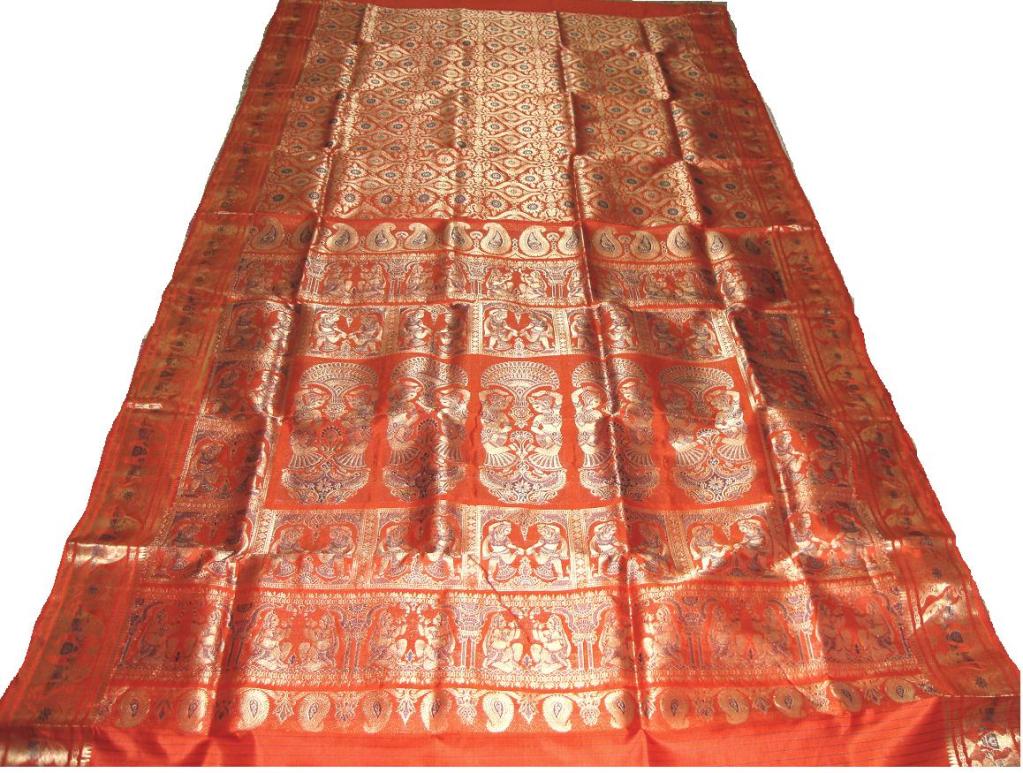 |
| Baluchari Saree with Ramayana Scene |
 |
| Baluchari Saree with Dancing Lady |
 |
| Baluchari Saree depicting a scene of Mahabharat with Krishna and Arjun |
 |
| Baluchari Saree depicting Festive Mood |
 |
| Baluchari Saree depicting courtship of Radha Krishna |
History
In the history of textile in Bengal, Baluchari Saree came much after Muslin. Two hundred years ago Baluchari was used to be practised in a small village called Baluchar in Murshidabad district, from where it got the name Baluchari. In the eighteenth century, Murshidkuli Khan, Nawab of Bengal patronized its rich weaving tradition and brought the craft of making this sari from Dhaka to the Baluchar village in Murshidabad and encouraged the industry to flourish. After a flood in the Ganga river and the subsequent submerging of the village, the industry moved to Bishnupur village in Bankura district. The sari industry prospered in Bishnupur, Bankura during the reign of the Malla dynasty.
Once Bishnupur was the capital of Malla dynasty and different kinds of crafts flourished during their period under the patronage of Malla kings. Temples made of terracotta bricks were one achievement of these rulers. A major influence of these temples can be seen in Baluchari sarees. Mythological stories taken from the walls of temples and woven on Baluchari sarees, is a common feature in Bishnupur.
But this flourishing trend later declined, specially during British rule, due to political and financial reasons and it became a dying craft as most of the weavers were compelled to give up the profession.
Later in the first half of twentieth century, Subho Thakur, a famous artist, felt the need of recultivating the rich tradition of Baluchari craft. Though Bishnupur was always famous for its silk, he invited Akshay Kumar Das, a master weaver of Bishnupur to his center to learn the technique of jacquard weaving. Sri Das then went back to Bishnupur and worked hard to weave Baluchari on their looms.
Process Of Making The Baluchari
The production process of Baluchari can be divided into several parts:-
Cultivation of cocoons:- Since the discovery so many years ago that the fibre or filament composing the cocoon of the silkworm can be constructed into a beautiful and durable fabric, silkworms have been bred for the sole purpose of producing raw silk.
Processing of yarns:- To make the yarn soft, it is boiled in a solution of soda and soap and then dyed in acid colour, according to the requirement of the saree. The yarn is stretched from both the sides in opposite directions putting some force with both palms. This process is needed to make the yarn crisper.
Motif making:- Baluchari saris often had depictions from scenes of Mahabharat and Ramayana.Making of the motifs for ‘pallavs’ and other part of Baluchari is in itself an intricate process. The design is drawn on a graph paper, it is coloured and punching is done using cards. After punching, these cards are sewed in order and fixed in the jacquard machine.
Weaving:- After jacquard loom has been introduced, weaving of a Baluchari saree takes five to six days to get completed. Two weavers work on it on shifting basis.The main material used is silk and the sari is polished after weaving.
Baluchari thus prepared becomes the sign of aristocracy, the attire of status. Maintenance of quality of Baluchari saree is taken care of precisely. The quality is checked from the stage of dying of the yarn to the packaging of the saree.
Use
These saris were mostly worn by women from upper class and households in India during festive occasions and weddings.











